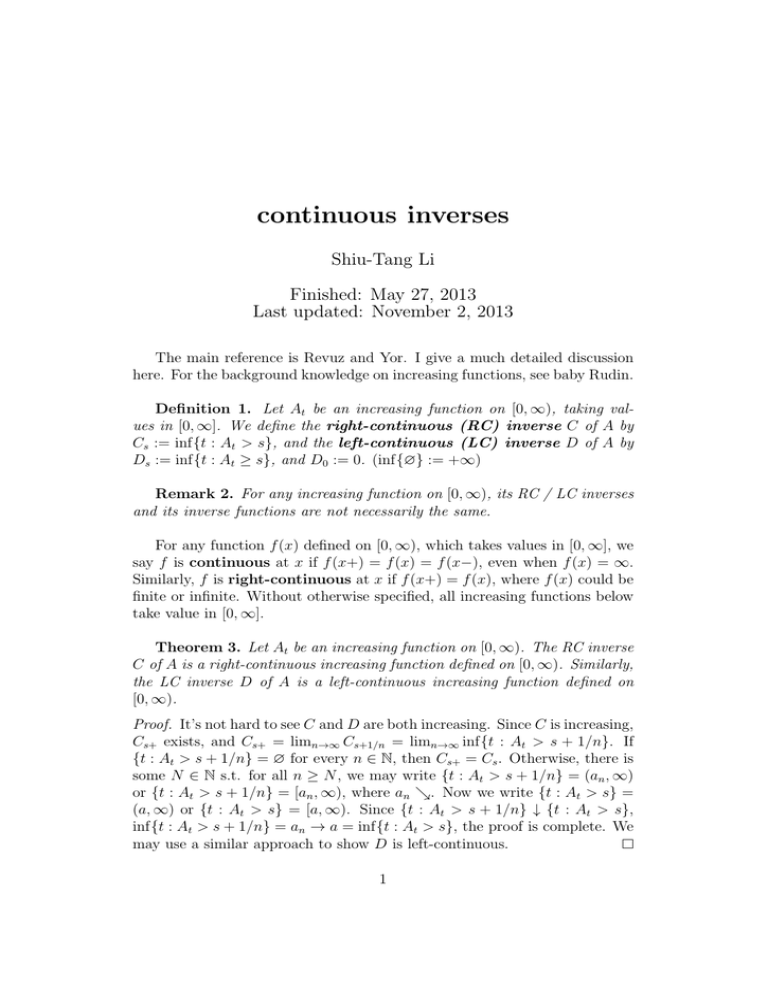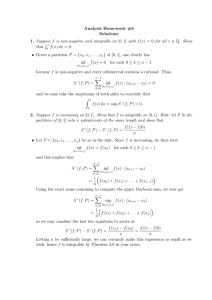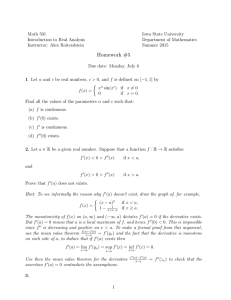continuous inverses Shiu-Tang Li Finished: May 27, 2013 Last updated: November 2, 2013
advertisement

continuous inverses
Shiu-Tang Li
Finished: May 27, 2013
Last updated: November 2, 2013
The main reference is Revuz and Yor. I give a much detailed discussion
here. For the background knowledge on increasing functions, see baby Rudin.
Definition 1. Let At be an increasing function on [0, ∞), taking values in [0, ∞]. We define the right-continuous (RC) inverse C of A by
Cs := inf{t : At > s}, and the left-continuous (LC) inverse D of A by
Ds := inf{t : At ≥ s}, and D0 := 0. (inf{∅} := +∞)
Remark 2. For any increasing function on [0, ∞), its RC / LC inverses
and its inverse functions are not necessarily the same.
For any function f (x) defined on [0, ∞), which takes values in [0, ∞], we
say f is continuous at x if f (x+) = f (x) = f (x−), even when f (x) = ∞.
Similarly, f is right-continuous at x if f (x+) = f (x), where f (x) could be
finite or infinite. Without otherwise specified, all increasing functions below
take value in [0, ∞].
Theorem 3. Let At be an increasing function on [0, ∞). The RC inverse
C of A is a right-continuous increasing function defined on [0, ∞). Similarly,
the LC inverse D of A is a left-continuous increasing function defined on
[0, ∞).
Proof. It’s not hard to see C and D are both increasing. Since C is increasing,
Cs+ exists, and Cs+ = limn→∞ Cs+1/n = limn→∞ inf{t : At > s + 1/n}. If
{t : At > s + 1/n} = ∅ for every n ∈ N, then Cs+ = Cs . Otherwise, there is
some N ∈ N s.t. for all n ≥ N , we may write {t : At > s + 1/n} = (an , ∞)
or {t : At > s + 1/n} = [an , ∞), where an &. Now we write {t : At > s} =
(a, ∞) or {t : At > s} = [a, ∞). Since {t : At > s + 1/n} ↓ {t : At > s},
inf{t : At > s + 1/n} = an → a = inf{t : At > s}, the proof is complete. We
may use a similar approach to show D is left-continuous.
1
Remark 4. In general, An → A doesn’t imply inf An → inf A. Example:
, −1 , · · · } ∪ {1}.
consider An = { −1
n n+1
Theorem 5. Let At be an increasing function on [0, ∞), and let C, D be
its RC, LC inverses, respectively. Then we have Cs− = Ds and Cs = Ds+ ,
for all s ≥ 0.
Proof. The proof is quite similar to the one in Theorem 3.
Theorem 6. Let At be an increasing function on [0, ∞), and let C, D be
its RC, LC inverses, respectively. Then (1) A ≡ s < ∞ on an finite interval
in R+ if and only if ∞ > Cs > Ds ; (2) A ≡ s < ∞ on an infinite interval in
R+ if and only if ∞ = Cs > Ds ; (3) That there exists exactly one t ≥ 0 s.t.
At = s, or {t : At > s} =
6 ∅ and there is no t ≥ 0 s.t. At = s, is equivalent
to ∞ > Cs = Ds ; (4) At < s for all t ≥ 0 if and only if ∞ = Cs = Ds .
Proof. (1)(⇒) Let A ≡ s only on [a, b], [a, b), (a, b], or (a, b), from definition
we discover that Cs = b and Ds = a.
(⇐) Conversely, we assume that ∞ > Cs > Ds . If the statement
“A ≡ s < ∞ on an finite interval in R+ ” does not hold, then either At 6= s
for all t ≥ 0, or At = s for exactly one t0 ≥ 0. (If At = s on an infinite
interval in R+ , then Cs = ∞, a contradiction to our assumption.)
For the first case, {t : At ≥ s} = {t : At > s}, so Cs = Ds , a contradiction. For the second case, Cs = Ds = t0 , which is still a contradiction.
(2)(⇒) Let A ≡ s only on [a, ∞) or (a, ∞). We have Cs = ∞ and Ds = a.
(⇐) Cs = ∞ ⇔ {t : At > s} = ∅, Ds < ∞ ⇔ {t : At ≥ s} 6= ∅.
Therefore, there exists t0 ≥ 0 s.t. At0 = s, and At = s for all t ≥ t0 . It is not
hard to see from here that A ≡ s < ∞ on an infinite interval in R+ .
(3)(⇒) See (1)(⇐).
(⇐) Since ∞ > Cs = Ds , we have inf{t : At > s} = inf{t : At ≥ s} < ∞.
There’re only two possibilities: (a) {t : At > s} = {t : At ≥ s}, which implies
that {t : At = s} = ∅ and {t : At > s} =
6 ∅. (b) {t : At = s} is a single point.
(4)(⇒) Straightforward from definition.
(⇐) If At ≥ s for some t ≥ 0, then Ds < ∞, a contradiction.
2
Theorem 7. Let At be an increasing function on [0, ∞), and let C be
its RC inverse. Then (1) C ≡ t < ∞ on an finite interval in R+ if and
only if ∞ > At+ > At− ; (2) C ≡ t < ∞ on an infinite interval in R+ if and
only if ∞ = At+ > At− ; (3) That there exists exactly one s ≥ 0 s.t. Cs = t,
or {s : Cs > t} 6= ∅ and there is no s ≥ 0 s.t. Cs = t, is equivalent to
∞ > At+ = At− ; (4) Cs < t for all s ≥ 0 if and only if ∞ = At+ = At− .
Proof. (1)(⇒) There exists a < b < ∞ s.t. inf{z : Az > a} = inf{z : Az >
b} = t. For any x > t, Ax > b because inf{z : Az > b} = t. For any y < t,
Ay ≤ a because inf{z : Az > a} = t. Therefore, At+ ≥ b > a ≥ At− . Besides,
we have At+ < ∞, for otherwise Ax = ∞ for all x > t, and Cs = t for all
s > At+ , which implies C ≡ t < ∞ on an infinite interval in R+ .
(⇐) For At− < s < At+ , Cs = t. If Az = At+ for all z > t, then
CAt+ = ∞ > t. If Az > At+ for some z > t, then CAz +1 > t.
(4)(⇒) Assume At− < ∞. If At+ = ∞, then for all s > At− , Cs = t, a
contradiction. If At+ < ∞, then CAt+ +1 ≥ t, again a contradiction. Thus,
At+ = At− = ∞.
(⇐) If Cs0 = inf{z : Az > s0 } ≥ t for some s0 ≥ 0, then for any x < t,
Ax ≤ s0 , which implies At− < ∞, a contradiction.
(2)(⇒) By assumption, Cs = t for all s large, which implies {z : Az >
s} = (t, ∞) for all s large, or {z : Az > s} = [t, ∞) for all s large. This
means Az = ∞ for all z > t, thus At+ = ∞. By what we’ve proved in (4),
the only possibility is that At− < At+ = ∞.
(⇐) It’s easy to see that Cs = t for all s > At− .
(3)(⇒) By (1),(2),(4), the only possibility is that ∞ > At+ = At− .
(⇐) Let s = At− = At = At+ :
If Az > s for all z > t, then Cs = t, and for any s0 > s, Cs0 > Cs = t.
If Cs0 = Cs , then Az > s0 for all z > t, which implies At+ ≥ s0 > s = At , a
contradiction. Next, for any s0 < s, there exists some t0 < t s.t. s0 < At0 ≤ s
by At− = At . Therefore, Cs0 ≤ t0 < t = Cs .
If Az = s for all z > t, then {s : Cs > t} = ∅, which is a contradiction to
our assumption.
3
If Az = s for z ∈ [t, t + δ), and Az0 > s for some z 0 ≥ t + δ, then
z 0 ≥ Cs ≥ t + δ, and Cs0 < t for all s0 < s by the discussions above.
Theorem 8. Let At be an increasing function on [0, ∞), and let C, D be
its RC, LC inverse, respectively. Then (1) C ≡ t < ∞ on an finite interval
in R+ if and only if so is D; (2) C ≡ t < ∞ on an infinite interval in R+ if
and only if so is D; (3) That there exists exactly one s ≥ 0 s.t. Cs = t, or
{s : Cs > t} =
6 ∅ and there is no s ≥ 0 s.t. Cs = t, is equivalent to the same
statement with C replaced by D ; (4) Cs < t for all s ≥ 0 if and only if so is
D.
Proof. (1), (2), (4) are straightforward. For (3)(⇒), assume that Cs = Cs+ =
t, Cz > t for all z > s, and Cz < t for all z < s. We have Dz > t for all z > s,
and Ds = Cs− . If Cs− < t, then there’s no z s.t. Dz = t, and {z : Dz > t} is
nonempty. If Cs− = t, then s is the only number s.t. Ds = t. This is because
Dz = Cz− ≤ Cz < t for all z < t.
Next, we assume that there is no z ≥ 0 s.t. Cz = t, and {y : Cy > t} =
6 ∅.
It’s not hard to see t ∈ [Cs− , Cs ] for some s ≥ 0 (C0− := 0). If t = Cs− , then
s is the only number s.t. Ds = t. If Cs > t > Cs− , then there is no z ≥ 0 s.t.
Dz = t, and {y : Dy > t} =
6 ∅, since {y : Cy > t} =
6 ∅.
Theorem 9. Let At be an increasing function on [0, ∞). We have
inf{t : At > s} = sup{t : At ≤ s} and inf{t : At ≥ s} = sup{t : At < s}.
(Here we define sup{∅} = 0)
Theorem 10. Let At be an increasing function on [0, ∞). Then TFAE:
(1) supt≥0 At = s < ∞.
(2) Cz = ∞ for all z > s, Cz < ∞ for all z < s.
(3) Dz = ∞ for all z > s, Dz < ∞ for all z < s.
Proof. (1) ⇒ (2) and (1) ⇒ (3) are obvious. Assume (2), we have {t :
At > z} = ∅ for all z > s, therefore At ≤ s for all t ≥ 0. Besides,
{t : At > s − } =
6 ∅, hence supt≥0 At ≥ s − . It follows that (2) ⇒ (1). The
proof of (3) ⇒ (1) is similar.
Theorem 11. Let At be an increasing function on [0, ∞). Then TFAE:
(1) sups≥0 Cs = a < ∞.
(2) sups≥0 Ds = a < ∞.
(3) At = ∞ for all t > a, At < ∞ for all t < a.
4
Proof. (1) ⇒ (3): by (1) we have inf{t : At > s} ≤ a for all s ≥ 0. If
there exists b > a so that Ab < ∞, then inf{t : At > Ab + 1} = ∞ or
∞ > inf{t : At > Ab + 1} ≥ b > a, both results contradict our assumption.
If there exists c < a s.t. Ac = ∞, then inf{t : At > s} ≤ c for all s ≥ 0,
which implies sups≥0 Cs ≤ c < a, a contradiction. (2) ⇒ (3) is similar.
(3) ⇒ (1): since {t : At > n} ↓ {t : At = ∞}, we have Cn ↑ a (use
similar arguments as in Theorem 3). As a result, sups≥0 Cs = a. (3) ⇒ (2)
is similar.
Duality for RC / LC increasing functions
Theorem 12. Let At be a RC increasing function on [0, ∞), and let C
be the RC inverse of A. Then we have ACs ≥ s (if Cs < ∞) and At = inf{s :
Cs > t}.
Proof. (1) Since ACs + > s for all > 0, let ↓ 0 we have ACs ≥ s by right
continuity of A.
(2) Assume At < ∞. Since A is RC, for all small enough we have
At+ < ∞. We observe that CAt+ := inf{z : Az > At+ } ≥ t + > t. Therefore, At+ ≥ inf{s : Cs > t}. Let ↓ 0, we have At ≥ inf{s : Cs > t} by right
continuity of A.
For any ∞ > s0 ≥ inf{s : Cs > t}, we have Cs0 = inf{z : Az > s0 } > t,
and this implies At ≤ s0 . This means inf{s : Cs > t} ≥ At .
Next we assume that At = ∞. For any s ≥ 0, Cs = inf{z : Az > s} ≤ t.
Therefore, {z : Cz > t} = ∅, and inf{z : Cz > t} = ∞ = At .
Theorem 13. Let At be an LC increasing function on [0, ∞), and let D
be the LC inverse of A. Then we have At = inf{s : Ds ≥ t}.
Proof. Assume At < ∞. By definition of D, we have DAt− = inf{z : Az ≥
At− } ≤ t − < t. Therefore, At− ∈
/ {s : Ds ≥ t}, and At− ≤ inf{s : Ds ≥
t}. Let ↓ 0, we have At ≤ inf{s : Ds ≥ t} by left-continuity of A.
On the other hand, for any s0 < ∞ and inf{s : Ds ≥ t} > s0 , we have
Ds0 = inf{z : Az ≥ s0 } < t (even when {s : Ds ≥ t} = ∅), and hence
At ≥ s0 . This shows At ≥ inf{s : Ds ≥ t}.
5
Now we assume that At = ∞. For any s ≥ 0, Ds := inf{z : Az ≥ s} ≤ t.
If there is some s0 ≥ 0 s.t. Ds0 = t, then At− < s0 by the definition of D.
Let ↓ 0, At ≤ s0 , a contradiction. Therefore, for all s ≥ 0, we have Ds < t.
This implies {s : Ds ≥ t} = ∅, and inf{s : Ds ≥ t} = ∞.
Strictly increasing ⇔ continuous
Theorem 14. Let At be an increasing function on [0, ∞), and let C, D
be the RC, LC inverse of A, respectively. Then, C (or D) is continuous on
[Aa , Ab ] if and only if A is strictly increasing on [a, b].
Proof. For any s ∈ [Aa , Ab ], that there is no interval (finite or infinite) on
which A ≡ s, is equivalent to the fact that Cs = Ds < ∞ or Cs = Ds = ∞
(by Theorem 6), which holds if and only if C (or D) is continuous on [Aa , Ab ].
Theorem 15. Let At be an increasing function on [0, ∞), and let C, D
be the RC, LC inverse of A, respectively. Then TFAE:
(1) A is continuous on [Ca , Cb ].
(2) C is strictly increasing on [a, b].
(3) D is strictly increasing on [a, b].
(4) A is continuous on [Da , Db ].
Proof. (1) ⇔ (2): for any t ∈ [Ca , Cb ], that there is no interval (finite or
infinite) on which C ≡ t, is equivalent to the fact that At− = At+ < ∞ or
At− = At+ = ∞ (by Theorem 7), which holds if and only if A is continuous
on [Ca , Cb ].
(3) ⇔ (4): similar. (by Theorem 7 and 8)
(2) ⇔ (3): for (⇐), for any c < d, c, d ∈ [a, b], k =
Cd− ≤ Cd , therefore Dc < Dd . (⇒) is similar.
c+d
,
2
Cc− ≤ Cc < Ck <
Theorem 16. Let At be an increasing function on [0, ∞), and At is
strictly increasing, continuous, and finite on [a, b]. Let C, D be the RC, LC
inverse of A, respectively. Then CAt = DAt = t for all t ∈ [a, b], and
ACs = ADs = s for all s ∈ [Aa , Ab ].
Proof. For any t ∈ [a, b], since At < ∞, {s : Cs > At } = (t, ∞), so CAt = t.
By Theorem 14, CAt = CAt − = DAt . Conversely, for any s ∈ [Aa , Ab ],
s = Ak for some k ∈ [a, b], by the intermediate value theorem (since At is
continuous on [a, b]). By what has been proved, CAk = DAk = k = Cs = Ds ,
so s = Ak = ACs = ADs .
6
Applications
Ta and St . T is the LC inverse of S. Since S is LC, S is also the LC
inverse of T . We can show that St is not strictly increasing on any [c, d],
S0 = 0, and St is continuous on any [c, d]. As a result, Ta . Therefore, Ta is
strictly increasing on [Sc , Sd ], but Ta is not continuous on [Sc , Sd ]. T0 = 0 by
definition.
Proof of Chap 0, 4.10
(Must revise the interval from [a, b] to (a, b]. We do not know if Au(a−) =
Au(a)− .)
First we’d like to prove the result for f (x) = 1(c,d] (x). Let (e, f ] =
(c, d] ∩ (u(a), u(b)], and it’s not hard to see RHS = Af − Ae . Next we assume
that (g, h] = (a, b] ∩ {s : u(s) ∈ (c, d]}, and LHS = Au(h) − Au(g) = Af − Ae .
The rest is by the monotone class theorem.
7







